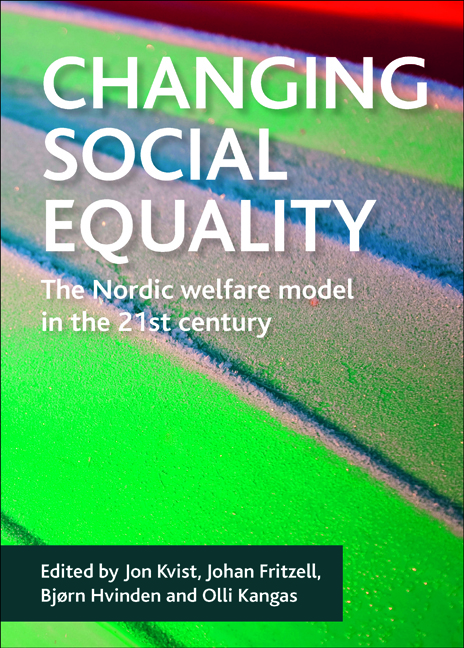Book contents
- Frontmatter
- Contents
- List of tables and figures
- Notes on contributors
- Acknowledgements
- one Changing social inequality and the Nordic welfare model
- two Anti-immigration attitudes, support for redistribution and party choice in Europe
- three Do we all (dis)like the same welfare state? Configurations of public support for the welfare state in comparative perspective
- four Eroding minimum income protection in the Nordic countries? Reassessing the Nordic model of social assistance
- five Equality in the social service state: Nordic childcare models in comparative perspective
- six Welfare state institutions, unemployment and poverty: comparative analysis of unemployment benefits and labour market participation in 15 European Union countries
- seven Social inequalities in health: the Nordic welfare state in a comparative context
- eight Income inequality and poverty: do the Nordic countries still constitute a family of their own?
- nine Is immigration challenging the economic sustainability of the Nordic welfare model?
- ten Nordic responses to rising inequalities: still pursuing a distinct path or joining the rest?
- Index
nine - Is immigration challenging the economic sustainability of the Nordic welfare model?
Published online by Cambridge University Press: 01 September 2022
- Frontmatter
- Contents
- List of tables and figures
- Notes on contributors
- Acknowledgements
- one Changing social inequality and the Nordic welfare model
- two Anti-immigration attitudes, support for redistribution and party choice in Europe
- three Do we all (dis)like the same welfare state? Configurations of public support for the welfare state in comparative perspective
- four Eroding minimum income protection in the Nordic countries? Reassessing the Nordic model of social assistance
- five Equality in the social service state: Nordic childcare models in comparative perspective
- six Welfare state institutions, unemployment and poverty: comparative analysis of unemployment benefits and labour market participation in 15 European Union countries
- seven Social inequalities in health: the Nordic welfare state in a comparative context
- eight Income inequality and poverty: do the Nordic countries still constitute a family of their own?
- nine Is immigration challenging the economic sustainability of the Nordic welfare model?
- ten Nordic responses to rising inequalities: still pursuing a distinct path or joining the rest?
- Index
Summary
Introduction
The idea that substantial immigration, especially from countries outside the rich West, is incompatible with a Nordic kind of welfare state, has been put forward in the debate on immigration. This chapter asks under what conditions immigration from countries outside the rich West is – or might become – a real and significant challenge to the economic sustainability of the Nordic welfare model. Immigration might, for instance, have an effect on wages and employment. More specifically, this chapter examines if immigration might lead to a financial weakening of the Nordic welfare state.
We ask to what extent immigration leads to net transfers from the welfare state to the immigrant population. If such net transfers were substantial, they could undermine public finances in the long term and through this, the sustainability of the Nordic welfare state. Given that immigration might influence public sector finances, the effects are likely to depend on the composition of the immigrant population, for example, in terms of origin, ethnicity, reason for migration, age and skills; the situation in the labour market; and the design of the welfare state.
The first part of this chapter explores a simplified account of the immigration story of the Nordic countries from the first decades after the Second World War up to the present day. The second part presents research on factors that might determine the actual effects of immigration on public financing, primarily the results of studies of Scandinavian countries, but for comparative purposes also the results for some other receiving countries. In the final part we build on the results of this research to summarise the economic effects of immigration and the possible responses to such effects related to the institutional design of Nordic welfare states.
Immigration to Western Europe in the first decades after the Second World War was mainly labour migration either from neighbouring countries or from Mediterranean countries (Greece, Italy, Portugal, Spain, Yugoslavia and Turkey). Many also came from former colonies such as India, Pakistan, Bangladesh, Indonesia, Algeria and the West Indies. It was a period of high economic growth with an unlimited supply of labour due to the large supply of immigrant labour (Kindleberger, 1967).
- Type
- Chapter
- Information
- Changing Social EqualityThe Nordic Welfare Model in the 21st Century, pp. 187 - 200Publisher: Bristol University PressPrint publication year: 2011



